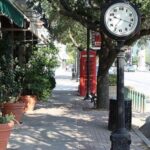Ancestors of the Seminole, who live on the Indian reservations today, were settled farmers and hunters in Spanish Territory of what is now north Florida. After three Seminole Wars during the 19th century, the Indians were forced out to Oklahoma. A few hundred hid in swamps of the Everglades.
Between 1790 and 1871, the U.S. Senate approved 380 treaties with Indian nations to acquire land. Congress offered in return- sovereignty and peace. After the smoke cleared at Wounded Knee, the general consensus was the American Indian was a dying breed. To witness them rolling in their Hummers and Harleys now would give Sitting Bull cause to gasp.
Seminoles resided in extended family camps- hunting, trapping and fishing. The railroad expansion into Florida by 1896 had extended to Miami. The Indians found themselves displaced from their campsites and hunting grounds. In 1906 the State of Florida devised a plan to drain the Everglades in an attempt to convert the entire wetlands into an agricultural center. The drainage canals lowered the water table causing dire consequences to the wildlife population.
In a 1931 report to the US Senate, Roy Nash, speaking for the Federal Indian Office stated: “The Seminole have been driven into most inhospitable swamps. Robbed of all security. Forced to abandon their cattle. The children of warriors have become drunkards and beggars.”
President Richard Nixon announced a new Indian self-determination policy in 1970 under which the tribe opened ‘Smoke Shops’ that sold tax-free cigarettes. Highly poetic justice since growing tobacco in the first US settlement- Jamestown had wiped out many of the Indian’s crops. In 1979, the tribe began un-regulated high stakes bingo, expanding to satellite sites which raised their income into millions.
The State of Florida was livid over the loss of tax revenues and fought all the way to the Supreme Court to stop the entrepreneurs. The Seminoles won by evoking their tribal sovereignty of tax-free status on the reservation.
During downtown construction, the city of Tampa, uncovered 19th century Seminole graves. Through clever negotiations the tribe agreed to removal of the remains as long as Tampa donated new burial ground. Tampa gave the Indians a parcel of land near the Interstate. The Seminole deeded the land back to the Federal Government, to be held in trust, creating a new tax-free sovereign. Along side their ancestors cemetery plots they build housing, a museum, smoke shops and a bingo hall on prime location property.
The Seminole opened the Sheraton Tampa East Hotel in 1986 on 31 acres adjacent to their Tampa Reservation. The project was paid for with a bank loan guaranteed 90% by Bureau of Indian Affairs; an almost 2 million Urban Development Action Grant matched by 2.5 million of Seminole Tribe funds.
By 2001, Seminole Tribe members saw profits reaching $300 million annually. Sharing the wealth between every man, woman and child with monthly dividends earned a family of four a yearly income of $96,000. The Seminole no longer release the amount of the dividend shares for privacy reasons. An insider source supposedly quoted a figure in 2007 that was more than doubled from previous years reports.
All Seminole Indians have access to comprehensive healthcare, which is run by tribe-health services. The reservations have their own ambulance service, law enforcement, water treatment plant and Fire Department. The tribe now receives 30 to 40 inquires per week from people who want to find out if they are Seminole and where to sign up for citizenship. Many requests begin by asking about the money. Their standard reply is “If someone in your family were a Seminole, chances are, you would know already.”
Sources:
Harry A. Kersey, The Florida Seminoles and the New Deal
Patsy West, The Enduring Seminoles
Betty Mae Tiger Jumper, A Seminole Legend
www.canku-luta.org


